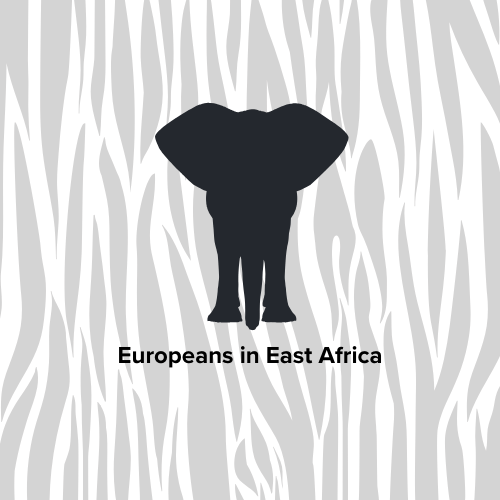Back to search results
Name: ROBERTS, Alick Oswald

Birth Date: 8 Dec 1889 Ladysmith, South Africa
Death Date: 15 Aug 1960 Aggetton Farm, Nanyuki, Kenya
First Date: 1912
Last Date: 1960
Profession: Farmer
Area: Waterloo Farm, Naivasha, 1922 - P.O. Suguroi, 1925 Aggetton, Nanyuki
Married: 1916 Elizabeth May Aggett who had arrived EA 1909, b. 3.10.1888 Eastern Cape, d. 3.5.1971 Nanyuki (dau of Thomas Edward Aggett)
Children: Boyce Kidson (4.2.1917 Nairobi-14.11.1974 Nanyuki); Dulcie May (Terre Blanche) (12.1.1919 Naivasha-16.1.1986); Iris Aggett (Swanson, Stanyon, Rankin, Mistry) (29.12.1921-23.4.1996 Kingsclere); Marjorie Weir Aggett (Murray) (28.4.1923-14.1.1993 Pretoria); Emily Dawn (Hayley) (26.9.1924 Nairobi-11.11.1974 Port Elizabeth)
Book Reference: Gillett, Barnes, Joelson, KAD, Red 25, EAWL, Red 31, RS, Hut, Red 22, Gazette, Red 19
War Service: Did Military Service in WW1 in EA
School: South Africa
General Information:
Gazette 6 Dec 1938 Aberdare Voters List
Daughters Marie married in SA, Iris married M. Rankin, Marjorie married Duirs of Hoey's Bridge, Emily married Mousley of Kiu. Source:- Mrs Ira Roberts [this doesn't tally with above - CN]
RS - Alick while dipping cattle was badly injured when an ox tossed its head and its horn went into his temple. Dr Tennent came from Nakuru, well over 100 miles over wet and bad roads. He operated a couple of days later on the kitchen table with hurricane lamps for illumination. Alick did not speak for 6 months and when he did his first word was 'Damn'. Story has it that the herdboy saved Alick's life by immediately covering the wound with a fresh cowpat. Alick originally worked for Dr. Doering at Waterloo Farm, between Gilgil and Naivasha. Elizabeth May was allotted a soldier settlement farm at Nanyuki at the end of the war to whence they moved from Waterloo. Alick was a great shot, winning many Bisley trophies
Gazette - 7/4/15 - Liable for Jury service, Naivasha - A.O. Roberts (British), Manager, Waterloo Farm, Naivasha
Nanyuki cemetery - Plot M17 AND Plot M16, Alick plus wife, and son Boyce. In loving memory / of / Alick Oswald Roberts / Dec 8th 1889 / Aug 15th 1960 / and / his wife / Elizabeth May Roberts / (née Aggett) Oct 3rd 1888 / May 3rd 1971
Gazette - 23/1/1918 - Registration of Brands - A.O. Roberts, Gilgil, Naivasha - Brand V9R - 19 Oct 1917
Gazette - 3/12/1919 - Register of Voters - Rift Valley Area - A.O. Roberts - Farmer - Gilgil and E. May Roberts - Married - Gilgil
Red Book 1919 - District Committees - Naivasha - A.O. Roberts
Joelson - 1928 - has imported 5 pedigree rams from S. Africa. Red 25 - Honorary Permit Issuer
Gazette - 5/8/1925 - Voters Register - Kenya Province - Alick Oswald Roberts, Settler PO Nanyuki and Elizabeth May Roberts, PO Nanyuki
Old Africa - 6-2-12 - Heather Rooken-Smith - My uncle Alec Roberts’s accident is well documented in both the Lancet and in our family history records. In those days when cattle were long horned, they had to be dipped every week against East Coast Fever, a deadly parasitic disease for which there was no inoculation.
A cattle dipping tank is a long narrow deep concrete structure, which is filled with water and into which they add a chemical mixture to kill ticks that carry the East Coast Fever. The cattle plunge into the tank and swim to the other end, by which time the chemical has affected any ticks. Once the cattle are out of the tank, there are concrete paths at angles from the tank, with strong upright poles and beams in which the cattle stand giving time for the dip mixture to run off their bodies and return down the channels to the main tank.
Uncle Alec stood alongside one of these cattle races branding his oxen and his Maasai herders worked alongside him. An ox with very long horns shook itself to get rid of the water, tossing its head at the same time. One of its horns pierced uncle Alec’s temple and went into his brain. The horn came out with a piece of brain hanging down his face. A Maasai standing nearest Uncle Alec picked up a clump of new cattle dung and clapped it on to the side of Uncle Alec’s temple, thereby ensuring no more brain could come out. He was then carried to the kitchen and laid out on a table, where he lay awaiting the arrival of Dr Tennant of Nakuru, who had been sent for. The roads were quite awful and it was several days before the doctor operated on Uncle Alec, using hurricane lamps for illumination. In the meantime his wife, Aunty May Roberts, my mother’s sister, who was a nurse, took care of Uncle Alec. Eventually they sent Uncle Alec to England where the doctors said the quick action of the Maasai and the fresh cowpat had saved his life.
In England the doctors said no more could possibly have been done for him. He was away for a very long time being taught to walk and talk again. We are told the first word he said was ‘damn.’ Returning to Kenya by ship, he went back to all that he previously did on his farm ‘Aggetton’ in Nanyuki.
Bruce Rooken-Smith May, having been a matron during the GEA campaign, was entitled to purchase land under the Soldier Settlement Scheme - Aggetton, where a junior school was established and run by Preto Shepherd - she was later to marry May's younger bro George.
Back to search results

